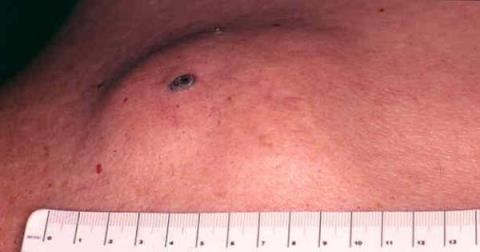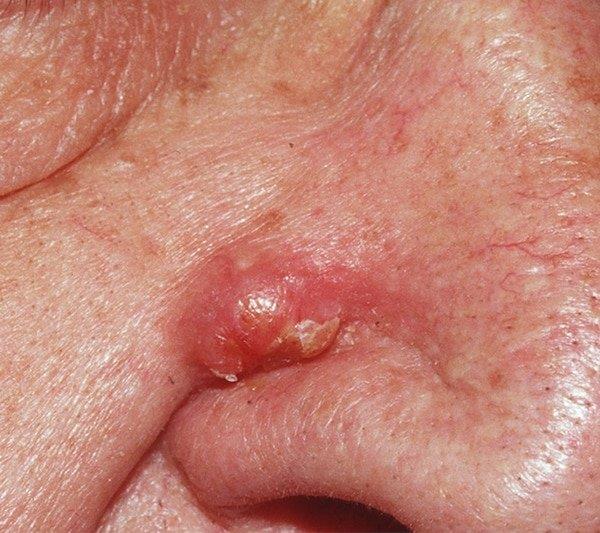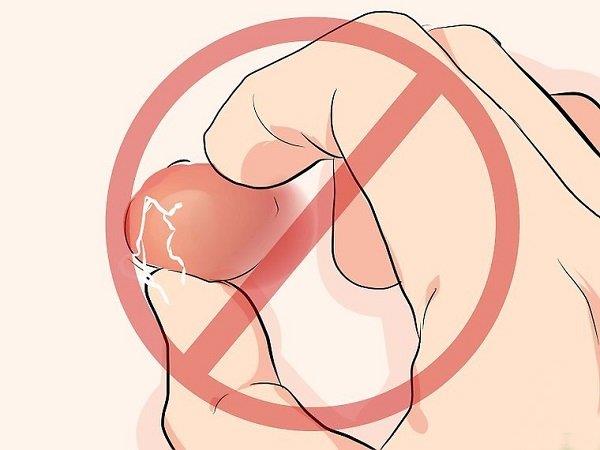Epidermoid cyst: The most common type of cyst in the skin

Epidermoid cysts are the most common type of skin tumor, originating in the epidermis or epithelium (top layer) of the skin. The disease usually occurs in young to middle-aged adults. The location can be anywhere, but is most concentrated on the face, neck, chest and genitals. Epidermoid cysts grow slowly and are usually painless. So they rarely cause health problems or require treatment. You may choose to have the cyst removed for cosmetic reasons, causing discomfort or pain, rupture, or infection.

content
- I. What are the symptoms of cysts?
- II. Causes of epidermal cysts
- III. Progression and complications:
- IV. How to diagnose epidermoid cyst?
- IV. How are cysts treated?
- V. Home care
I. What are the symptoms of cysts?
Includes the following features:
- Small, round, firm or tender bump, the same color as the skin, or yellow. Size varies from a few millimeters to several centimeters
- The u center may have a black hole plugged in
- Location of focus on the face, upper body neck, genitals
- The thin capsule shell surrounds the keratin- and lipid-rich debris of white, yellow color with an odor.
- Cysts can burst, causing inflammation or infection, swelling, redness, and pain.

Many people refer to epidermal cysts as sebaceous cysts, but they are different. Sebaceous cysts are actually very uncommon. They originate deep under the skin, arising from the sebaceous glands in the hair follicles, which secrete an oily substance that lubricates the hair and skin.
II. Causes of epidermal cysts

The surface of the skin (epidermis) is made up of a thin, protective layer of cells that the body. These cells are constantly shedding and renewing. Most epidermal cysts form when these cells move deeper under your skin and multiply instead of shedding. Sometimes cysts form due to irritation or damage to the skin or hair follicles.
Epidermal cells make up the wall of the cyst and then secrete the protein keratin that accumulates inside the cyst. Keratin is a protein that occurs naturally in skin cells. It is a thick, yellow substance that sometimes drains from the cyst. The abnormal growth of these cells can be caused by damaged, blocked hair follicles or skin.
These cysts can develop for a number of reasons. But damage to the skin is often thought to be the main cause. Occasionally, underlying genetic disorders such as Gardner syndrome can be the cause.
Risk factor
Anyone can get one or more, but these factors make you more susceptible:
- Past puberty
- Have some rare genetic disorders
- Damaged skin
III. Progression and complications:
Potential complications of the disease include:
Inflammation: Epidermoid cysts can be swollen and tender even when not infected. Inflamed cysts are difficult to remove. Once the inflammation subsides, the cyst is operable.
Rupture: A ruptured cyst causes the yellow fluid inside to leak out. It often leads to a boil-like infection that requires prompt treatment. At this point, it can be confused with other skin infections.
Abscess: Cysts can become severely infected, swollen, hot, red, and painful. Secretions that need to be drained contain pus, sometimes with blood.
Cancer: In very rare cases, epidermoid cysts can progress to skin cancer .

Epidermoid cyst in the nose
>> Skin cancer is a very serious disease, should not be subjective. When you go to see a Dermatologist to check on skin cancer, do you know what you should prepare yourself for? SignsSymptomsList will share with you some tips to make your skin cancer examination experience smoother and more effective!
IV. How to diagnose epidermoid cyst?
To diagnose an epidermoid cyst , your doctor will examine the bump and surrounding skin, as well as take your medical history. They will evaluate in detail how long the bump has appeared and whether it has changed over time, and other consistent symptoms to distinguish it from other causes.
Doctors can diagnose epidermoid cysts by physical examination and palpation. But sometimes an ultrasound or referral to a dermatologist is needed to confirm the diagnosis.
Blood and secretion tests
Testing the fluid in the cyst is not usually necessary. However, with recurrent infections or unresponsiveness to antibiotics, samples are taken for bacterial culture and for antibiogram.
Image analysation
If an epidermoid cyst is suspected in an unusual location, such as breast, bony, or intracranial location. Imaging with ultrasound, X-ray, CT scan or MRI is necessary.
Other tests:
Fine-needle aspiration may be used to help diagnose epidermoid cysts in unusual locations, such as the breast. The specimen will be stained and examined under a microscope for keratin.
IV. How are cysts treated?
Epidermoid cysts do not go away completely on their own. Since a cyst is not dangerous or poses a health risk, it can be left alone if it does not cause cosmetic discomfort. If you want treatment, there are the following methods:
If the cyst becomes red, swollen or painful, changes size, or becomes infected, medication may be needed. In such cases, treatment options often include antibiotics. Sometimes the cyst can also be drained or injected with medication to help reduce swelling and pain.
Incision and drainage:
With this method, the doctor will make a small cut on the cyst and gently push out the fluid inside. This is a pretty quick and easy method. but cysts often recur after this treatment.
Minor surgery:
Epidermoid cysts can be completely removed. This is a small, safe and effective surgery and often prevents the cyst from coming back. If your cyst becomes inflamed, your doctor will delay surgery. The doctor will advise you in detail about the technique as well as should or shouldn't
V. Home care
You cannot prevent the formation and development of the disease. But scarring and infection can be prevented by:

Do not squeeze, pick or squeeze epidermoid cysts by yourself
Self-extracting or self-extracting cysts can lead to inflammation and/or infection. The action also runs the risk of forming around which leads to a difficult cesarean section and a larger surgical scar. It is best to leave it in place.
Keeping cysts clean
To prevent infection, you need to keep the cyst and the surrounding skin clean. Wash with soap or antibacterial cream every day.
When there is inflammation
A warm, damp cloth can be applied to the cyst. This helps to make the tumor smaller and heal faster. Apply a towel to the cyst 2-3 times per day.
Let epidermal cysts drain naturally
Once the cyst begins to drain, you should cover the cyst with sterile gauze and change the gauze twice daily. A doctor should be seen if large amounts of pus begin to drain from the cyst, the surrounding skin turns red and the cyst becomes warm and painful, or blood begins to ooze from the cyst.
>> Proper skin care is one of the important factors in preventing and repelling skin problems, especially for epidermal cysts. What is an effective skin care method? Let's get acquainted with these basic skin care steps with SignsSymptomsList !
Epidermoid cysts are very common in adults. This is a benign lesion. However, very rare cases of development of malignancy have been reported. Today, with many modern technical methods, lasers can be used to remove cysts gently, painlessly, and leave small scars. You should see your doctor for more detailed advice on the best treatment for you.